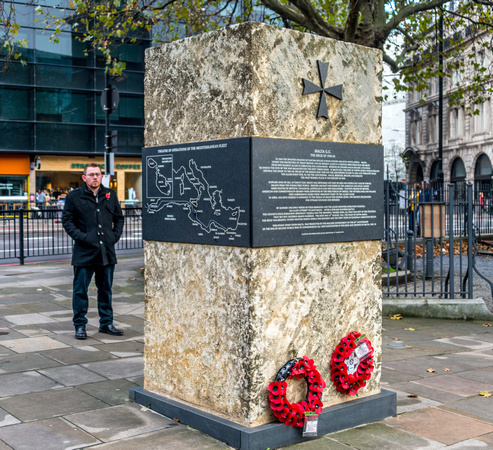The memorial for those lost in the siege of Malta GC.
The body of the memorial is made from a solid block of stone from Gozo, a neighbouring island of Malta, as the national stone of Malta was rather softer and less able to stand up to the weather conditions which prevail in the United Kingdom.
It stands some three metres high and on each of its four sides is a plaque setting out part of the story of the sacrifice of some 7,000 Maltese men and women and Commonwealth and Allied servicemen and women who lost their lives in defence, of Malta.
Each of the four sides has a carved slate slab.
The front of the memorial reads:
"Malta G.C. The Siege of 1940-43. In 1940 the sinister shadow of Fascism spilled across Europe and into North Africa. Malta, under the protection of Great Britian, found herself alone in a hostile Mediterranean 800 miles from her nearest allies in Gibraltar and Alexandria. Besieged by enemies Malta became a fulcrum on which the fate of the war balanced for the next three years. If Malta fell the rest of North Africa would follow. Opening the door to the oil fields of the Middle East and for the Axis Powers to join in Asia and threaten India. The allies knew this. So did the Axis Powers. Malta, besieged, became and reamins the most bombed place in the history of War.
Supplied only by Sea, at great cost, Malta was defened not only by her own people but by forces drawn from the whole free world. Fighter aircraft delivered by the American and Royal Navies were piloted by Britons, Canadians, Australians, and New Zealanders. Convoys crewed by British, American and Commonwealth seamen were supported by the free forces of Greece, the Netherlands, and Poland. Free Norwegians added their merchant fleet to the Allied cause. In April 1942 King George VI awarded to the People of Malta the George Cross, the highest decoration for civilian courage and heroism.
By Summer 1942 only weeks of food remained and the Allies mounted operation Pedestal as a last attempt to save Malta. After a five-day running battle the Convoy's four remaining merchant vessels and the immortal Tanker Ohio, all that was left of the fourteen that set out, entered the Grand Harbour. The date was 15th August, 1942, the feast of Santa Maria. The siege was broken; within months North Africa was retaken and the first steps of European liberation begun.
This stone taken from Malta, was presented by the Maltest Government on the 60th Anniversary of the end of the Second World War to commemorate all who participated in the siege and defence of Malta, 1940-43.
Placed by the George Cross Island Associalation, 15th, August 2005."
The second side contains more details about the siege.
The third side contains details about the George Cross award and the tribute by President Roosevelt.
The fourth side contains a map showing the theatre of operations in the Mediterranean.


